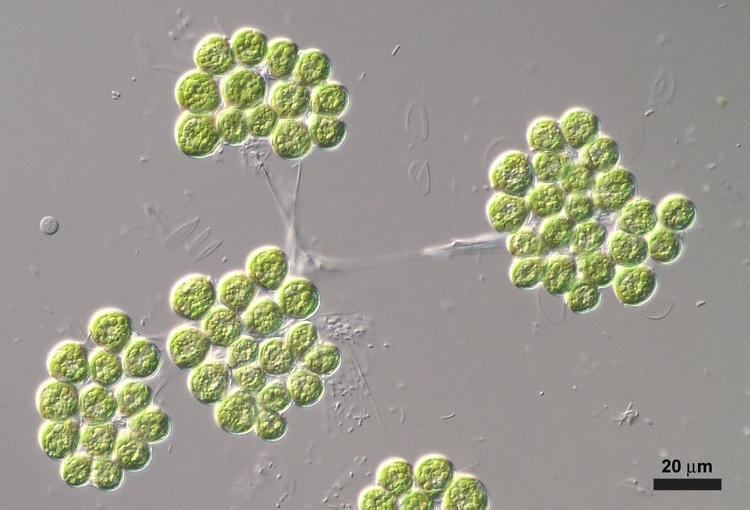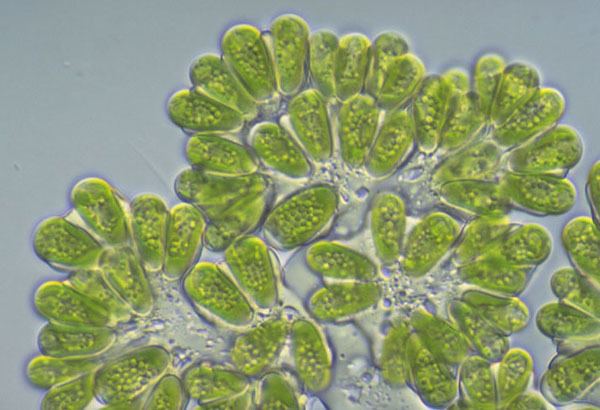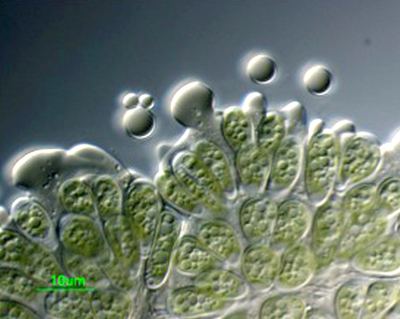Kingdom Plantae Order incertae sedis Higher classification Botryococcus | Scientific name Botryococcus braunii Rank Species | |
 | ||
Similar Botryococcus, Scenedesmus, Ankistrodesmus, Nannochloropsis, Chlorella vulgaris | ||
My lab set up growing botryococcus braunii
Botryococcus braunii (Bb) is a green, pyramid-shaped planktonic microalga that is of potentially great importance in the field of biotechnology. Colonies held together by a lipid biofilm matrix can be found in temperate or tropical oligotrophic lakes and estuaries, and will bloom when in the presence of elevated levels of dissolved inorganic phosphorus. The species is notable for its ability to produce high amounts of hydrocarbons, especially oils in the form of Triterpenes, that are typically around 30–40% of their dry weight. Compared to other green algae species it has a relatively thick cell wall that is accumulated from previous cellular divisions; making extraction of cytoplasmic components rather difficult. Fortunately, much of the useful hydrocarbon oil is outside of the cell.
Contents
- My lab set up growing botryococcus braunii
- Botryococcus braunii growth explosion under red light
- Optimal growth environment
- Toxic blooms and competition
- Biofuel applications of Botryococcus oils
- Oils
- Research
- Potentially useful strains
- References

Botryococcus braunii growth explosion under red light
Optimal growth environment

Botryococcus braunii has been shown to grow best at a temperature of 23 °C, a light intensity of 60 W/m², with a light period of 12 hours per day, and a salinity of 0.15 molar NaCl. However, this was the results of testing with one strain, and others certainly vary to some degree. In the laboratory, B. braunii is commonly grown in cultures of Chu 13 medium .
Toxic blooms and competition

Blooms of Botryococcus braunii have been shown to be toxic to other micro-organisms and fishes. The cause of the blooms and their subsequent damage to the populations of other organisms has been studied. The exudate of Bb in the form of free fatty acids has been identified as the cause. A higher alkalinity changes these free fatty acids into a form which is more toxic to other species, thus causing Bb to become more dominant. Higher alkalinity often occurs when ashes from burned areas are washed into a body of water. While the dominance of Bb can be seen as damaging to the environmental diversity of a body of water, the knowledge of how Bb can gain and maintain dominance is useful to those who intend to grow ponds of it as a fuel crop.
Biofuel applications of Botryococcus oils

The practice of farming cultivating is known as algaculture. Botryococcus braunii has great potential for algaculture because of the hydrocarbons it produces, which can be chemically converted into fuels. Up to 86% of the dry weight of Botryococcus braunii can be long-chain hydrocarbons. The vast majority of these hydrocarbons are botryocuccus oils: botryococcenes, alkadienes and alkatrienes. Transesterification can NOT be used to make biodiesel from Botryococcus oils. This is because these oils are not vegetable oils in the common meaning, in which they are fatty acid triglycerides. While Botryococcus oils are oils of vegetable origin, they are inedible and chemically very different, being triterpenes, and lack the free oxygen atom needed for transesterification. Botryococcus oils can be used as feedstock for hydrocracking in an oil refinery to produce octane (gasoline, a.k.a. petrol), kerosene, and diesel. (see vegetable oil refining). Botryococcenes are preferred over alkadienes and alkatrienes for hydrocracking as botryococcenes will likely be transformed into a fuel with a higher octane rating.
Oils

Three major races of Botryococcus braunii are known, and they are distinguished by the structure of their oils. Botryococcenes are unbranched isoprenoid triterpenes having the formula CnH2n-10. The A race produces alkadienes and alkatrienes (derivatives of fatty acids) wherein n is an odd number 23 through 31. The B race produces botryococcenes wherein n is in the range 30 through 37 biofuels of choice for hydrocracking to gasoline-type hydrocarbons. The "L" strain makes an oil not formed by other strains of Botryococcus braunii. Within this major classification, various strains of Botryococcus will differ in the precise structure and concentrations of the constituent hydrocarbons oils.

According to page 30 on Aquatic Species Program (ASP) report, the A-strain of Botryococcus would not function well as a feedstock for lipid-based fuel production due to its slow growth (one doubling every 72 hours). However, subsequent research by Qin showed that the doubling time could be reduced to 48 hours in its optimal growth environment. In view of findings by Frenz, the doubling times may not be as important as the method of hydrocarbon harvest. The ASP also found A-strain Botryococcus oil to be less than ideal, having most of its lipids as C29 to C34 aliphatic hydrocarbons, and less abundance of C18 fatty acids. This evaluation of Bb oils was done in relation to their suitability for transesterification (i.e. creating biodiesel), which was the focus of the ASP at the time Bb was evaluated. The ASP did not study Bb oils for their suitability in hydrocracking, as some subsequent studies have done on the "B" race.
The two listed C36H62 entries are not typos; they are for two different isomers
Research
Due to the burgeoning interest in alternatives to fossil fuels, there has been renewed research interest in Botryococcus braunii. The DOE Joint Genome Institute is sequencing the DNA of Bb in 2009–2010. B. braunii is also the subject of research into the natural production of butylated hydroxytoluene (BHT), an antioxidant, food additive, and industrial chemical.
Potentially useful strains
This heading is a collection of strains of note because of their potential utility. Some of these strains are patented as a result of active DNA modification; furthermore, others are from traditional selection processes.
In 1988, UCBerkeley was granted US Plant Patent 6169 for Botryococcus braunii variety Showa, developed by UC Berkeley scientist Arthur Nonomura, in the Melvin Calvin Laboratory as part of the Nobel laureate's groundbreaking interdisciplinary program for the development of renewable transport fuels. The proprietary variety was notable, says the patent application, because of its highly reproducible botryococcenes hydrocarbon content comprising 20% of the dry weight of "Showa." It is clear that Showa was borne out as the top source of hydrocarbons of its time. The patent expired in April 2008.
In May 2006, Nonomura filed an international patent application disclosing novel growth and harvesting processes for the Chlorophyta. A separate patent for plants is also filed on Botryococcus braunii variety Ninsei that exhibits the feature of extracolonial secretion of it botryococcenoids that can be processed in existing gasoline refineries to transport fuels.
In August 2011, variety Enomoto was announced by IHI NeoG Algae LLC. It has "...the highest yield for this fuel production over all the algae that have been discovered in the world", with a claimed monthly growth a thousand times higher than normal Bb strains. It is additionally said to be very robust, presumably meaning it could be grown in an open environment (in ponds, instead of photobioreactors).
